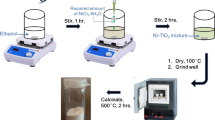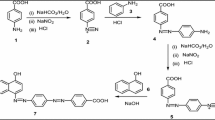Abstract
Dye-sensitized solar cells based on nitrogen-doped nanocrystalline titanium dioxide (TiO2) electrodes have shown improved photovoltaic performance due to the beneficial effects of nitrogen on the electronic and optical properties of TiO2. In this context, we report synthesis, characterization and photoelectrochemical studies of N-doped TiO2 prepared by sol–gel method using methylamine (MA), aniline (A) and furfurylamine (FA) as N dopants. For the comparison, the undoped TiO2 (TiO2–U) was also prepared, keeping all the other experimental conditions identical. The materials obtained have been characterized for optical properties, crystalline structure and surface morphology. The nanocrystalline N-doped TiO2 powders obtained were found to possess different crystallite sizes, surface areas and N-doping levels. When thin films of these TiO2 samples were used as photoanodes in dye-sensitized solar cell (DSSC), taking N719 dye as a sensitizer dye, cell with N-doped (TiO2–A) photoanode showed maximum conversion efficiency with an OCP (V oc) of 0.58 V, current density (J sc) of 1.99 mA cm−2, fill factor (FF) of 0.75 and overall conversion efficiency (η) of 0.86 % under illumination of 100 mW cm−2 light intensity. The maximum incident photon to current conversion efficiency (IPCE) of cell was 75 %, whereas with TiO2–U used as a photoanode and sensitized by N719 dye J sc of 1.61 mA cm−2 could be obtained, demonstrating that the short-circuit photocurrent density of the cell based on N-doped TiO2 electrode increases by more than 20 % compared to the undoped TiO2. Photovoltaic performances were found in the following order: TiO2–A > TiO2–U > TiO2–MA > TiO2–FA.












Similar content being viewed by others
References
Regan BO, Gräetzel M (1991) A low-cost, high-efficiency solar cell based on dye-sensitized colloidal TiO2 films. Nature 353:737–740
Tachikawa T, Fujitsuka M, Majima T (2007) Mechanistic insight into the TiO2 photocatalytic reactions: design of new photocatalysts. J Phys Chem C 111:5259–5275
Asahi R, Morikawa T, Ohwaki T, Aoki A, Yaga Y (2001) Visible-light photocatalysis in nitrogen-doped titanium oxides. Science 293:269–271
Rengifo-Herrera JA, Pierzchala K, Sienkiewicz A, Forro L, Kiwi J, Pulgarin C (2009) Abatement of organics and Escherichia coli by N, S co-doped TiO2 under UV and visible light. Implications of the formation of singlet oxygen (1O2) under visible light. Appl Catal B Environ 88:398–406
Irie H, Watanabe Y, Hashimoto K (2003) Nitrogen-concentration dependence on photocatalytic activity of TiO2 − x N x powders. J Phys Chem B 107:5483–5486
Yin S, Yamaki H, Komatsu M, Zhang QW, Wang JS, Tang Q, Saito F, Sato T (2003) Preparation of nitrogen-doped titania with high visible light induced photocatalytic activity by mechanochemical reaction of titania and hexamethylenetetramine. J Mater Chem 13:2996–3001
Prabakar K, Takahashi T, Nezuka T, Takahashi K, Nakashima T, Kubota Y, Fujishima A (2008) Visible light-active nitrogen-doped TiO2 thin films prepared by DC magnetron sputtering used as a photocatalyst. Renew Energ 33:277–281
Duarte DA, Massi M, Sobrinho ASS (2014) Development of dye-sensitized solar cells with sputtered N-doped TiO2 thin films: from modeling the growth mechanism of the films to fabrication of the solar cells. Int J Photoenergy. doi:10.1155/2014/839757
Rahman MYA, Umar AA, Saad SKM, Salleh MM, Ishaq A (2014) Effect of dye on the performance of nitrogen doped TiO2 solar cell prepared via ammonia treated liquid phase deposition technique. J New Mat Electrochem Syst 17:33–37
Yang K, Dai Y, Huang B (2007) Study of the nitrogen concentration influence on N-doped TiO2 anatase from first-principles calculations. J Phys Chem C 111:12086–12090
Bellardita M, Addamo M, Paola AD, Palmisano L, Venezia AM (2009) Preparation of N-doped TiO2: characterization and photocatalytic performance under UV and visible light. Phys Chem Chem Phys 11:4084–4093
Aita Y, Komatsu M, Yin S, Sato T (2004) Phase-compositional control and visible light photocatalytic activity of nitrogen-doped titania via solvothermal process. J Solid State Chem 177:3235–3240
Wu Z, Dong F, Zhao W, Guo S, Hazard J (2008) Visible light induced electron transfer process over nitrogen doped TiO2 nanocrystals prepared by oxidation of titanium nitride. J Hazard Mater 157:57–63
Qin W, Lu S, Xi W, Wang S (2013) Dye-sensitized solar cell based on N-doped TiO2 electrodes prepared on titanium. Int J Electrochem Sci 8:7984–7990
Liu S-H, Syu J-W (2013) N-doped mesoporous titania as a photoelectrochemical working electrode for dye-sensitized solar cells. Int J Electrochem Sci 8:336–346
Qiu X, Burda C (2007) Chemically synthesized nitrogen-doped metal oxide nanoparticles. Chem Phys 339:1–10
Horikawa T, Katoh M, Tomida T (2008) Preparation and characterization of nitrogen-doped mesoporous titania with high specific surface area. Microporous Mesoporous Mater 110:397–404
Yang G, Jiang Z, Shi H, Xiao T, Yan Z (2010) Preparation of highly visible-light active N-doped TiO2 photocatalyst. J Mater Chem 20:5301–5309
Geng J, Yang D, Zhu J, Chen D, Jiang Z (2009) Nitrogen-doped TiO2 nanotubes with enhanced photocatalytic activity synthesized by a facile wet chemistry method. Mater Res Bull 44:146–150
Park HK, Kim DK, Hee C (1997) Effect of solvent on titania particle formation and morphology in thermal hydrolysis of TiCl4. J Am Ceram Soc 80:743–749
Yeung KL, Yau ST, Maira AJ, Coronado JM, Soria J, Yue PL (2003) The influence of surface properties on the photocatalytic activity of nanostructured TiO2. J Catal 219:107–116
Huo Y, Jin Y, Zhu J, Li H (2009) Highly active TiO2 − x − y N x F y visible photocatalyst prepared under supercritical conditions in NH4F/EtOH fluid. Appl Catal B Environ 89:543–550
Jin YS, Kim KH, Choi HW (2010) Properties of TiO2 films prepared for use in dye-sensitized solar cells by using the sol-gel method at different catalyst concentrations. J Korean Phys Soc 57:1049–1053
Zhiyuan Y, Anning Z (2007) Effects of nitrogen doping on microstructure and photocatalytic activity of nanocrystalline TiO2 powders. J Wuhan Univ Technol Mater Sci Ed. doi:10.1007/s11595-006-3457-8
Kang SH, Kim HS, Kim J-Y, Sung Y-E (2010) Enhanced photocurrent of nitrogen-doped TiO2 film for dye-sensitized solar cells. Mater Chem Phys 124:422–426
Sing K, Everett D, Haul R, Moscou L, Pierotti R, Rou-querol J, Siemieniewska T (1985) Reporting physisorption data for gas/solid systems with special reference to the determination of surface area and porosity. Pure Appl Chem 57:603–619
Acknowledgments
One of the author’s (R.K.) acknowledges the financial support received from the University Grants Commission, New Delhi, and the Ministry of New and Renewable Energy (MNRE), New Delhi, for this work. We thank Prof. O.N. Srivastava, Department of Physics, Banaras Hindu University, for providing XRD, SEM and TEM facilities, and Prof. Alain Walcarius and Aurélien Renard of the Laboratoire de Chimie Physique et Microbiologie pour l’Environnement (LCPME), Université de Lorraine, France, for XPS and BET analysis.
Author information
Authors and Affiliations
Corresponding author
Rights and permissions
About this article
Cite this article
Kushwaha, R., Chauhan, R., Srivastava, P. et al. Synthesis and characterization of nitrogen-doped TiO2 samples and their application as thin film electrodes in dye-sensitized solar cells. J Solid State Electrochem 19, 507–517 (2015). https://doi.org/10.1007/s10008-014-2623-8
Received:
Revised:
Accepted:
Published:
Issue Date:
DOI: https://doi.org/10.1007/s10008-014-2623-8




